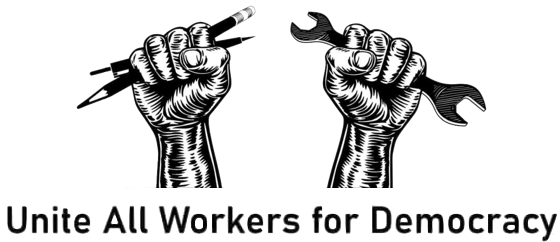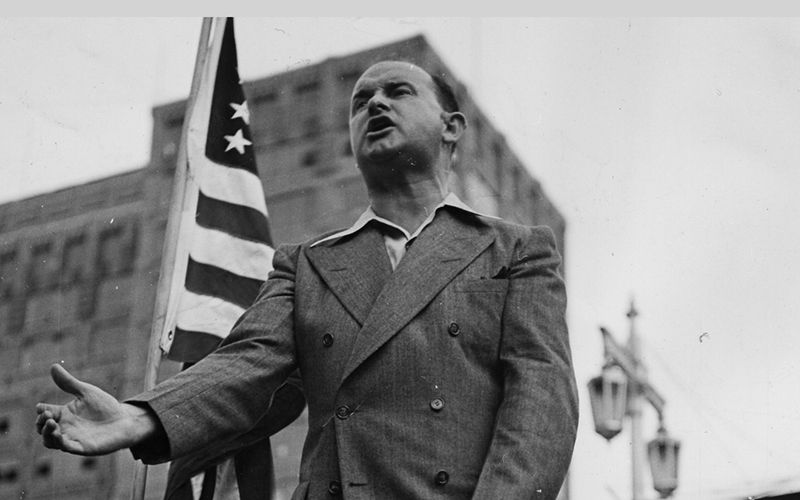Follow Erik Loomis on Twitter
Read Erik Loomis at Lawyers, Guns, & Money
Historian Erik Loomis on This Day in Labor History: August 10, 1935. Transit Worker Union members descend on a New York jail to demand the release of their leaders, including Mike Quill, after they were beaten and arrested. Let’s talk about the rise of the TWU and Irish nationalism in the labor movement!
Most of the New York subways were privately operated in the 1930s. The city ran some of it, but there were two companies also involved: the Interborough Rapid Transit Company and Brooklyn-Manhattan Transit Corporation.
The urban transportation industry was as anti-union as any in the nation and like those industries, they had formed toothless company unions in the 1920s to supposedly give workers a voice without giving them any power at all.
There were a few skilled worker unions on the BMT, but they represented only a handful of workers. Many of the transit workers were Irish and no small number of them were immigrants. Probably half of the New York transit workers in the early 1930s were born in Ireland.
This was a hard, low-paying job that new immigrants could get and also get for their family members coming over. The trolley and bus companies were even more Irish-dominated, maybe 3/4 Irish born.
And while we think of the peak of Irish immigration as escaping the famine in the 1840s and 1850s, which is true, Irish immigration remained quite consistent for another century.
As the 1924 Immigration Act did not negatively affect Irish immigration because it was set to 1880 levels of immigration by nation, it was still pretty much open borders for the Irish.
It wasn’t just the rank and file workers who were Irish. It was true of much of the newly forming union leadership as well, including Mike Quill.
He had fought in the Irish Republican Army between 1919 and 1921, coming to the United States in 1926 and getting a job on the trains, working as a ticket agent.
The Communist Party had been attempting to organize transit workers since 1933. But because these workers didn’t really labor in large workplaces, mostly working by themselves, building up effective organizing was hard.
In April 1934, Mike Quill and six others met in a cafeteria at Columbus Circle, along with Communist Party members, and talked about the need to form a real union.
As they said, they wanted to fight “the misery, the labor spies, the blacklists, the firings, the yellow‐dog contracts, the discrimination.” But Quill and the other TWU members, happy to work with the communists, effectively deployed their ties of Irish nationalism.
In fact, the TWU name built on the Irish traditions of Jim Larkin and James Connolly, who had formed the Irish Transport and General Workers Union twenty years earlier.
Explicitly connecting the new leftism with Irish republicanism was a way to build ideas of solidarity within the workforce, giving them a common identity as workers to rally around. The CP was able to recruit mostly from those who had ties to Irish nationalism.
Quill for instance was not a leftist in any real sense when he came to the U.S. But influenced by his life in Ireland, he started making connections between the Irish struggle and that of workers globally, not to mention himself.
The TWU built upon the longtime militancy of urban transportation workers and were ready to take advantage of the new conditions of the New Deal to demand their rights. These were workers who really needed unionization. At times, they might work 70-84 hour weeks.
Quill was willing to take on the very real physical threat of being a lead organizer. Making yourself public was a great way to get beaten up or worse. But Quill decided it was a risk worth taking.
The CP convinced Quill and a few others to infiltrate the company union in order to recruit there, which he initially resisted, but which proved to be an effective strategy in industries with large company union structures, including steel.
In July 1935, the nascent TWA began pushing the envelope. On July 9, six squeegee workers, who cleaned the glass of the trains, refused to use the more difficult and heavy 14 inch squeegees instead of the standard 10 inch ones. They were fired.
The workers were ready for this and mobilized to protest the termination of their comrades. Two days later, after a strike, the workers were reinstated. The organizing continued.
On August 10, as Quill and the others–Herbert C. Holmstrom, Thomas H. O’Shea, Patrick McHugh and Serafino Machado–were about to enter union headquarters
The New York Police Department — happy to work with the companies — then arrested the union leaders for inciting a riot, even though they had done nothing of the sort.
But the workers were ready to act and immediately descended upon the courthouse, collecting their own money to bail them all out. They were released within the day. The courts threw out the charges. And this incident became organizing lore in the TWU.
Over the next few years, 30,000 workers would gain union contracts thanks to the militancy of the TWU and the new organizing framework of the New Deal. It became one of the first unions to join the CIO.
It took a few years to build up the union but by the end of 1936, it pretty much dominated the IRT and was moving on to other companies.
They had to contend with growing opposition from the Catholic Church, which was not opposed to unionism per se, but was very strongly opposed to any union with communist ties, which the TWU very much had at this time.
On other hand, with Dorothy Day using her column in Catholic Worker to tell workers to join the TWU, the church’s message was divided.
Moreover, there was a lot of anticlericalism among the Irish workers at this time because the church had been opposed to violence in the republicanism movement, disgusting many.
By the summer of 1937, the TWU was winning election after election in the new labor regime ushered in by the National Labor Relations Act. It soon moved beyond New York and began organizing transit workers in other cities.
Quill built upon these victories to become one of the most important labor leaders in New York.
He was able to organize both non-Irish transit workers in other cities and Irish workers in other industries who had nothing in common with the transit workers except for a shared Irish nationalism and identity.
He distanced himself from the communists he ran with as a younger man when it was no longer useful for him and was a threat to his union. But he maintained an emphasis on militancy within the union.
Using his thick Irish brogue to its full extent and combining that with a harsh wit, many a politician learned the hard way not to mess with the TWU. For his last act, he took on and defeated John Lindsay in the 1966 strike and then died immediately after.

